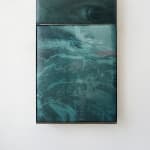Neringa Vasiliauskaitė Lithuanian, b. 1984
Bodies of Water/1, 2025
Aliuminio rėmas, spauda ant tekstilės, pagalvėlių užpildas, biologinės kilmės epoksidinė derva, balsos mediena / Aluminum frame, print on textile, cushion filling, bio-based epoxy resin, balsa wood
140 x 76 x 4 cm
Further images
In 'Bodies of Water,' Neringa Vasiliauskaitė unfolds a series of works that trace poetic correspondences between the eye and the net, the act of seeing and the gesture of catching....
In 'Bodies of Water,' Neringa Vasiliauskaitė unfolds a series of works that trace poetic correspondences between the eye and the net, the act of seeing and the gesture of catching. The retina – both biologically and etymologically – shares its roots with the net: a woven, receptive structure where impressions land, are filtered, remembered. This entanglement becomes a conceptual thread throughout the series, where vision, chance, and desire converge into material form.
The eye here is not merely a site of perception but a porous interface between interior and exterior worlds, between body and environment. Vasiliauskaitė’s compositions, built through layering photographic fragments, embroidery, glass-like resin, and carved wood, evoke the tactile memory of surfaces – moist, fragile, reflective. Embedded words like 'intention,' 'energy,' or '2024' function as quiet spells or floating notations, charged with the ambiguity of time and desire. The result is a visual language that is simultaneously intimate and symbolic, soft yet precise.
At the core of her work lies a fascination with mimicry and transformation — the way a motif, form, or gesture can shift its meaning entirely through context, material, or scale. A fishing net becomes a retinal map; a gaze becomes a landscape; a decorative element becomes a container of myth. These visual parallels and slippages are not accidental but carefully staged manipulations, where one thing poses as another — not to deceive, but to deepen our ways of seeing. The artist constructs 'chains' of association, where one element morphs into the next: a continuum of transformation rather than a fixed identity. Meaning is not static but migratory — relational, embodied, shifting.
Threads of luck — its pursuit, performance, and projection — run through the work like subtle undercurrents. Lucky coins, smiling fish, netted structures allude to rituals of wishful thinking and symbolic offerings, infused with a tender, slightly ironic gaze at the human need to anchor meaning in signs. The 'catch,' in this context, is as much about randomness as it is about longing — a choreography of hope and illusion. Vasiliauskaitė’s works hover between object and image, often suggesting protective or bodily functions – an eyelid, a shell, a pouch. They address the viewer not through spectacle, but through proximity and resonance. By aligning the anatomical with the emotional, the linguistic with the visual, Bodies of Water proposes a sensual topology of perception: where vision becomes fluid, and the act of looking itself becomes a ritual of holding, releasing, and transforming.
The eye here is not merely a site of perception but a porous interface between interior and exterior worlds, between body and environment. Vasiliauskaitė’s compositions, built through layering photographic fragments, embroidery, glass-like resin, and carved wood, evoke the tactile memory of surfaces – moist, fragile, reflective. Embedded words like 'intention,' 'energy,' or '2024' function as quiet spells or floating notations, charged with the ambiguity of time and desire. The result is a visual language that is simultaneously intimate and symbolic, soft yet precise.
At the core of her work lies a fascination with mimicry and transformation — the way a motif, form, or gesture can shift its meaning entirely through context, material, or scale. A fishing net becomes a retinal map; a gaze becomes a landscape; a decorative element becomes a container of myth. These visual parallels and slippages are not accidental but carefully staged manipulations, where one thing poses as another — not to deceive, but to deepen our ways of seeing. The artist constructs 'chains' of association, where one element morphs into the next: a continuum of transformation rather than a fixed identity. Meaning is not static but migratory — relational, embodied, shifting.
Threads of luck — its pursuit, performance, and projection — run through the work like subtle undercurrents. Lucky coins, smiling fish, netted structures allude to rituals of wishful thinking and symbolic offerings, infused with a tender, slightly ironic gaze at the human need to anchor meaning in signs. The 'catch,' in this context, is as much about randomness as it is about longing — a choreography of hope and illusion. Vasiliauskaitė’s works hover between object and image, often suggesting protective or bodily functions – an eyelid, a shell, a pouch. They address the viewer not through spectacle, but through proximity and resonance. By aligning the anatomical with the emotional, the linguistic with the visual, Bodies of Water proposes a sensual topology of perception: where vision becomes fluid, and the act of looking itself becomes a ritual of holding, releasing, and transforming.










